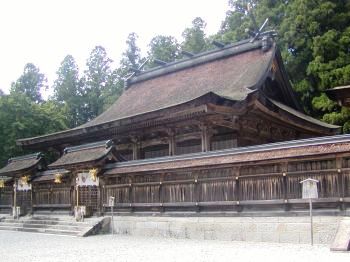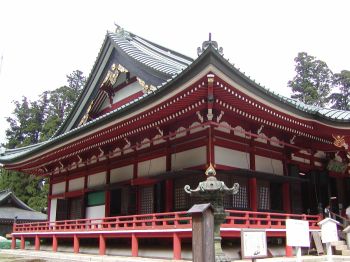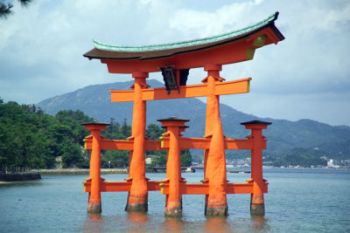Japanese Buddhism
 Buddhism originated in India in the 6th Century BC. Buddhism is a religion and a philosophy. It consists of the teachings of Gautama Siddhartha. According to his idea we have to realise the truth of the world, by training ourselves in the Middle Way, avoiding the extremes of self- indulgence and self-mortification. The purpose of Buddhism is to obtain Enlightenment, which is an absolute tranquillity of mind never disturbed by emotions. Buddhism is now divided in two major schools, which are “Theravada” (Hinayana) and “Mahayana”.
Buddhism originated in India in the 6th Century BC. Buddhism is a religion and a philosophy. It consists of the teachings of Gautama Siddhartha. According to his idea we have to realise the truth of the world, by training ourselves in the Middle Way, avoiding the extremes of self- indulgence and self-mortification. The purpose of Buddhism is to obtain Enlightenment, which is an absolute tranquillity of mind never disturbed by emotions. Buddhism is now divided in two major schools, which are “Theravada” (Hinayana) and “Mahayana”.
Theravada succeeds to the thought of Gautama faithfully. To obtain Enlightenment believers have to practice Buddhistic disciplines once being monks in their lives. Theravada Buddhism is widely believed in Sri-Lanka and South East Asia. On the other hand Mahayana is spread through East Asia to Japan. Mahayana means a “Greater Vehicle”, on which lay believers can easily go into the state of Enlightenment. Bodhisattva (Bosatsu) has a great significance in Mahayana Buddhism. Bodhisattva is a person, who will strongly assist all-the-beings to achieve Enlightenment. With aid of Bodhisattva even lay believers are able to obtain salvation and to become Buddha.
Mahayana Buddhism was imported to Japan via Korean Peninsula in the 6th Century. While Buddhism was welcomed by the ruling nobles as Japan’s new state religion, it did not initially spread among the common people due to its complex theories.
There were also a few initial conflicts with Shinto, Japanese native religion, but the two religions were soon able to co-exist harmonically and even complemented each other.
 In the 8th Century the six sects of Buddhism were imported from China and several great Buddhist temples were erected in the capital of Nara. The Buddhism of this period was not a practical religion but was aimed to pray for the peace and prosperity of the state and imperial house. Therefore the great monasteries, such as the Todaiji, gained strong political influence and were one of the reasons for the government to move the capital to Kyoto in 794. Nevertheless, the problem of politically ambitious and militant monasteries remained a main issue for the governments over many centuries of Japanese history.
In the 8th Century the six sects of Buddhism were imported from China and several great Buddhist temples were erected in the capital of Nara. The Buddhism of this period was not a practical religion but was aimed to pray for the peace and prosperity of the state and imperial house. Therefore the great monasteries, such as the Todaiji, gained strong political influence and were one of the reasons for the government to move the capital to Kyoto in 794. Nevertheless, the problem of politically ambitious and militant monasteries remained a main issue for the governments over many centuries of Japanese history.
In the early 9th Century two great Buddhist priests studied new Buddhism in China and established their schools. Saicho founded the Enryakuji temple of the Tendai school in Kyoto and many sects later branched off the Tendai school. Kukai established the Kongobuji of the Shingon school at Mt.Koya. Shingon school belongs to esoteric Buddhism and some unique ceremonies are performed in the school.
During the Kamakura period, many new schools of Buddhism flourished. It should be said as the Reformation of Japanese Buddhism.
The Jodo school (Pure Land) was founded by Honen. It found followers among all different social classes since its theories were simple and based on the principle that everybody can achieve Enlightenment by strongly believing in the Buddha Amida. The only thing needed to followers is chanting the invocation of Amida and believing salvation. Shinran succeeded to the Jodo school and established the Jodo-Shinshu (True Pure Land). These two schools continue to have many millions of followers today.
Eisai and Dogen studied Zen in China and introduced Zen to Japan. Its complicated theories were popular particularly among the members of the military class. According to Zen teachings, one can achieve Enlightenment through meditation and discipline. At present Zen seems to enjoy a greater popularity overseas than within Japan.
Nichiren founded a particular school of Buddhism. Different from most Buddhist schools in Japan, Nichiren Buddhism was intolerant towards other religious schools. Nichiren persuaded people to follow his school. He was convinced that only Nichiren school can save Japan and Japanese. Nichiren Buddhism still has millions of believers now, and several “new religions” are based on Nichiren’s teachings.
Until the medieval period, the great Buddhist monasteries had the religious influence and the political power. The rulers fought the militant Buddhist monasteries thoroughly in the end of the 16th Century and practically extinguished their political activities. In the Edo period there were few obvious movements of Buddhism. Temples were built in the local governing system and gradually lost the religious enthusiasm.
Buddhist institutions were once more attacked in the early years of the Meiji period, when the new Meiji government favoured Shinto as the new state religion and tried to separate and emancipate it from Buddhism.
Nowadays most of people consider themselves Buddhists in Japan. However, the religion does not directly affect the everyday life of the average Japanese very strongly.
Some annual traditional ceremonies are performed by Buddhist style. Funerals are usually carried out in a Buddhist way, and the dead become Buddha soon after the death, with the aid of Bodhisattva. Many households keep a small house altar in order to pray to Buddha, who were once their ancestors.
Shinto
 Shinto (“the way of the gods”) is the indigenous faith of the Japanese people and as old as Japan herself. It remains Japan’s major religion besides Buddhism.
Shinto (“the way of the gods”) is the indigenous faith of the Japanese people and as old as Japan herself. It remains Japan’s major religion besides Buddhism.
Shinto does not have a founder nor does it have sacred scriptures like the sutras or Qur’an. Propaganda and preaching are not common either, because Shinto is deeply rooted in the Japanese rituals and traditions.
“Shinto gods” are called kami. They are sacred spirits which take the form of things and concepts important to life, such as wind, rain, mountains, trees, rivers and fertility. Among the people who believe in Shinto, humans become kami after they die and are revered by their families as ancestral kami. The kami of extraordinary people are even enshrined at some shrines. The Sun Goddess Amaterasu is considered Shinto’s most important kami.
In contrast to many monotheist religions, there are no absolutes in Shinto. There are a huge number of kami, which affect our lives. But Shinto is an optimistic faith, as humans are thought to be fundamentally good, and evil is believed to be caused by evil spirits. Consequently, the purpose of most Shinto rituals is to keep away evil spirits by purification, prayers and offerings to the kami.
Shinto shrines are the places of worship and the homes of kami. Priests of Shinto perform Shinto rituals and often live on the shrine grounds. Men and women can become priests, and they are allowed to marry and have children. Priests are supported by young ladies (miko) during rituals and concerning other tasks at the shrine.
 The introduction of Buddhism in the 6th century was followed by a few initial conflicts, however, the two religions were soon able to co-exist harmoniously and even complement each other. Many Buddhists viewed the kami as manifestations of Buddha.
The introduction of Buddhism in the 6th century was followed by a few initial conflicts, however, the two religions were soon able to co-exist harmoniously and even complement each other. Many Buddhists viewed the kami as manifestations of Buddha.
After the Meiji Restoration, Shinto was made Japan’s state religion. Shinto priests became state officials, important shrines started to received governmental funding, Japan’s creation myths were used to foster an emperor cult, and efforts were made to separate and emancipate Shinto from Buddhism. After World War 2, Japanese constitution prohibits the government aiding any kind of religions.
Shinto and Buddhism are Japan’s two major religions. They have been co-existing for several centuries and have even complemented each other to a certain degree.
Like Buddhism Shinto does not play a big role in the everyday life of most Japanese people today. The average person typically follows the religious rituals at ceremonies like birth, weddings and funerals. We may visit shrines or temples on New Year, and may participate in local festivals (matsuri), most of which have a religious background of Shinto.
